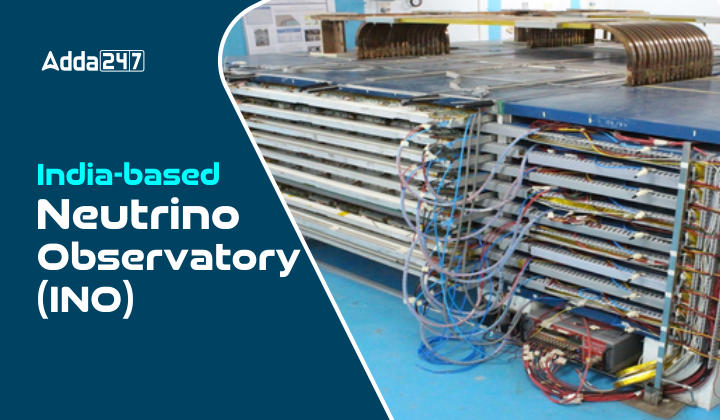Table of Contents
The Indian Neutrino Observatory (INO) has the potential to drive India forward in the nation of technology through its exploration of advanced research areas. This article clarifies the significance of neutrinos, underscores the importance of the Indian Based Neutrino Observatory, and explains the various types of neutrinos. Aspirants aiming for the UPSC Exam would find this article invaluable in their preparations.
India-based Neutrino Observatory (INO)
The Union Cabinet has given its nod for the establishment of the Indian Neutrino Observatory (INO) to study fundamental particles called neutrinos. Positioned in the Bodi West Hills area of Tamil Nadu’s Theni district, around 110 kilometers west of Madurai, this observatory intends to explore the enigmatic nature of neutrinos.
- The INO project entails the construction of an underground laboratory. Initially planned for the Nilgiris, the site was relocated to a cavern beneath a rocky mountain in the Bodi West Hills due to concerns about its proximity to tiger habitats.
- Collaboration between the Inter-Institutional Centre for High Energy Physics (IICHEP) and the Iron Calorimeter Detector (ICAL) is central to the project’s execution.
- Additionally, approval has been granted to build a magnetized Iron Calorimeter to explore the properties of neutrinos, particularly focusing on the mass hierarchy among various types of neutrinos. This facility is poised to become the world’s largest, weighing over 50,000 tonnes.
- Both the Department of Science and Technology and the Department of Atomic Energy are providing joint support for the INO project.
| India-based Neutrino Observatory (INO) Project | ||
| About |
building a world-class underground laboratory for non-accelerator-based high energy and nuclear physics research
|
|
| National Neutrino Collaboration Group (NNCG) |
includes more than 50 scientists from about 15 Institutes and Universities in India
|
|
| Management of Funds |
Department of Atomic Energy (DAE) and the Department of Science and Technology (DST)
|
|
| Objective |
To observe neutrinos and antineutrinos produced in Earth’s Atmosphere
|
|
| Prominent Features |
Underground laboratory, Construction of a magnetized Iron Calorimeter (ICAL) which will have the world’s largest magnet, Setting up Inter-Institutional Centre for High Energy Physics (IICHEP)
|
|
Neutrinos
Neutrinos, belonging to the Lepton family, are elementary, weakly interacting subatomic particles with half-integer spin. Proposed by Swiss scientist Wolfgang Pauli, they are the second most abundant particles in the universe, following only photons, the constituents of light. Unlike electrons, which are familiar to us, neutrinos lack electric charge, rendering them immune to electromagnetic forces.
- Neutrinos possess negligible mass.
- They are nearly massless.
- Being electrically neutral, they exclusively interact with the weak nuclear force.
Types of Neutrinos
There are three main types of neutrinos in Indian Neutrino Observatory , each linked to a specific charged lepton:
- Electron Neutrino (νₑ): This neutrino pairs with the electron, a fundamental subatomic particle with a negative charge. Electron neutrinos are involved in various nuclear reactions, including beta decay.
- Muon Neutrino (νµ): Partnering with the heavier and unstable muon, the muon neutrino arises in muon decay and other interactions involving muons.
- Tau Neutrino (ντ): The heaviest of the three, the tau neutrino accompanies the tau particle, another even heavier and short-lived subatomic particle. Tau neutrino production occurs in tau decays and other tau-related processes.
It’s important to note that for each neutrino type, there exists an antiparticle counterpart called an antineutrino. These antineutrinos have opposite properties like positive lepton number for some and play a role in antimatter processes.
Importance of India-based Neutrino Observatory
This is a very important topic to learn about the Indian Neutrino Observatory for General Knowledge or UPSC Examination. Following the points are the glims of the topics. Interest people should do this to gain more understanding.
- It will be the largest experimental facility in the country, fostering the development of cutting-edge technology and sophisticated instruments.
- This facility will enhance our understanding of neutrino particles, primarily sourced from the Sun and Earth’s atmosphere.
- Neutrinos could potentially aid in nuclear non-proliferation by remotely monitoring nuclear reactors.
- The research conducted here will contribute to developing physics models beyond the Standard Model of Particle Physics.
- Understanding neutrinos may assist in detecting oil and mineral deposits.
- Neutrinos offer a potential avenue for faster data transmission compared to current methods, as they can traverse the Earth.
- The impact of this research extends to diverse fields such as nuclear and particle physics, astrophysics, cosmology, and medical imaging.
- Neutrinos serve as carriers of universal information, rarely lost in their journey. Studying neutrinos at INO could shed light on the deepest mysteries of the universe.
Indian Neutrino Observatory UPSC
The India Neutrino Observatory (INO), which integrates science and technology with efforts to create the nation, is significant for the UPSC test. From a scientific perspective, it explores particle physics and advances our knowledge of the universe by studying neutrinos. It propels technological developments in material science and detection technology.
As a nation-building endeavor, it showcases India’s growing role in global science and innovation, potentially benefiting sectors like precision engineering. Understanding INO’s scientific and national significance is vital for addressing UPSC questions effectively.



 Longest River in India, Check Top 10 Lon...
Longest River in India, Check Top 10 Lon...
 Namdapha National Park - Tiger Reserve, ...
Namdapha National Park - Tiger Reserve, ...
 Peninsular Plateau of India- Decca Plate...
Peninsular Plateau of India- Decca Plate...




